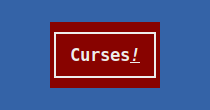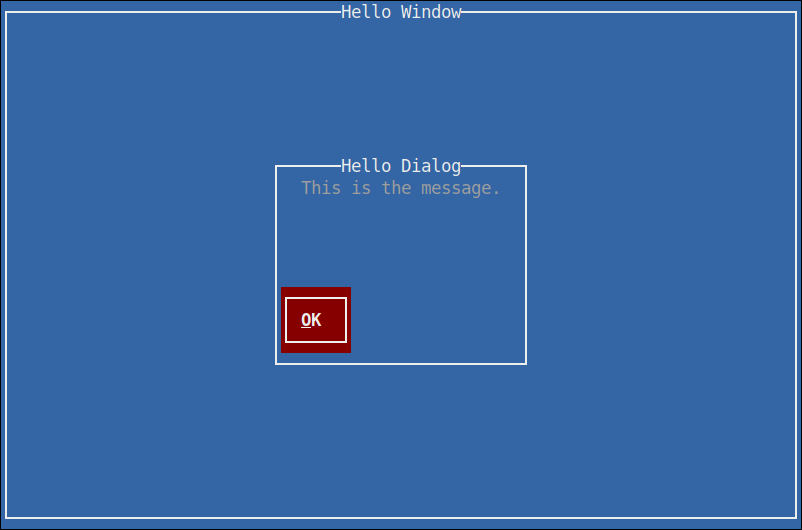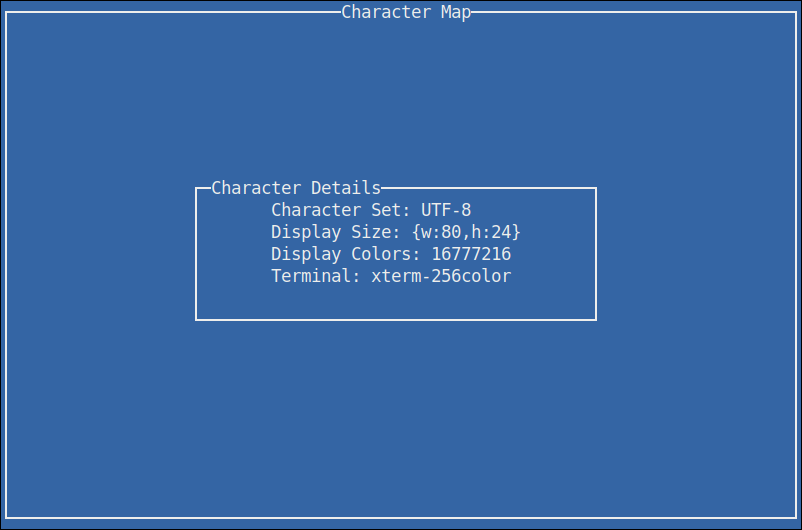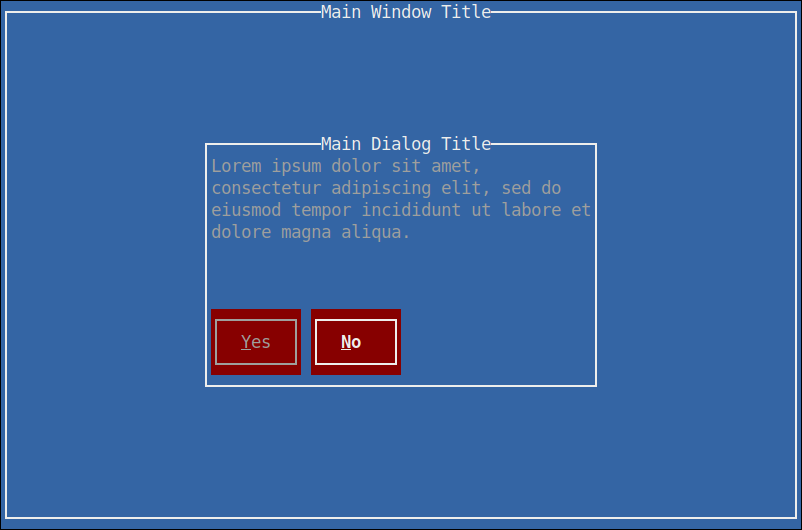Golang package to provide an advanced terminal user interface with a GTK inspired API, built upon CDK.
This project should not be used for any purpose other than intellectual
curiosity. This status is reflected in the tagged versioning of this trunk
branch, v0.5.x, ie: still experimental and unfinished yet getting near the
word "done".
CTK is a Go module and as such can be used in any of the typical Golang ways.
Go v1.21 (or later) is required in order to build and use the package. Beyond that, there aren't any other dependencies. Visit: https://golang.org/doc/install for installation instructions.
CTK uses the Go mod system and is installed in any of the usual ways.
$ go get github.com/go-curses/ctk@latest
The following application will display a window with "Hello World" as the title, containing a button centered nicely that when pressed will exit the application nicely.
package main
import (
"os"
"github.com/go-curses/cdk"
"github.com/go-curses/cdk/lib/enums"
"github.com/go-curses/cdk/log"
"github.com/go-curses/ctk"
)
func main() {
// Construct a new CDK application
app := cdk.NewApplication(
// program binary name
"hello-world",
// usage summary
"Simple Hello World example for CTK",
// description
"A simple terminal program written using the Curses Tool Kit",
// because versioning is important
"0.0.1",
// used in logs, internal debugging, etc
"helloWorld",
// used where human-readable titles are necessary
"Hello World",
// the TTY device to use, /dev/tty is the default
"/dev/tty",
// initialize the user-interface
func(d cdk.Display) error {
// tell the display to listen for CTRL+C and interrupt gracefully
d.CaptureCtrlC()
// create a new window, give it a human-readable title
w := ctk.NewWindowWithTitle("Hello World")
// get the vertical box for the content area of the window
vbox := w.GetVBox()
// here is where we add other widgets and such to implement the
// desired user interface elements, in this case we want a nice
// button in the middle of the window. One way to do this is to
// use an Alignment widget to place the button neatly for us.
align := ctk.MakeAlignment()
// the alignment scales are from 0 (left) to 1 (right) with the 0.5
// being centered
align.Set(0.5, 0.5, 0.0, 0.0)
// a nice button for us to press
button := ctk.NewButtonWithLabel("Curses<u><i>!</i></u>")
button.SetUseMarkup(true) // enable markup in the label
button.SetSizeRequest(11, 3) // request a certain size
// make the button quit the application when activated by connecting
// a handler to the button's activate signal
button.Connect(
ctk.SignalActivate,
"hello-button-handle",
func(data []interface{}, argv ...interface{}) enums.EventFlag {
d.RequestQuit() // ask the display to exit nicely
return enums.EVENT_STOP
},
)
align.Add(button) // add the button to the alignment
// finally adding the alignment to the window's content area by
// packing them into the window's vertical box
vbox.PackStart(align, true /*expand*/, true /*fill*/, 0 /*padding*/)
// tell CTK that the window and its contents are to be drawn upon
// the terminal display, this effectively calls Show() on the vbox,
// alignment and button
w.ShowAll()
// tell CDK that this window is the foreground window
d.SetActiveWindow(w)
// add a quit handler to say goodbye when the program exits
d.AddQuitHandler(
"hello-world-quit-handler",
func() {
// Note that the Display and other CTK things are no longer
// functional at this point.
fmt.Println("Hello World says Goodbye!")
// Logging however still works.
log.InfoF("Hello World logging goodbye!")
},
)
// no errors to report, nil to proceed
return nil
},
)
// run the application, handing over the command-line arguments received
if err := app.Run(os.Args); err != nil {
// doesn't have to be a Fatal exit
log.Fatal(err)
}
// end of program
}Compile the hello-world.go source file.
$ go build examples/hello-world/hello-world.go
View the command-line help:
$ ./hello-world -h
NAME:
hello-world - hello-world
USAGE:
hello-world [global options] command [command options] [arguments...]
VERSION:
0.0.1
DESCRIPTION:
the most basic CTK application
COMMANDS:
help, h Shows a list of commands or help for one command
GLOBAL OPTIONS:
--help, -h, --usage display command-line usage information (default: false)
--version display the version (default: false)
Run the program:
$ ./hello-world
Pressing the Curses! button will exit the program and print the quit message to the terminal, which should have cleanly cleared the screen and restored the terminal to shell control again.
CTK includes a number of command programs for the purpose of enabling a better developer experience or as a means of having a necessity in creating new widgets and features.
go-dialog is a dialog replacement, fully implemented in CTK and takes advantage of Glade interface files for implementing the user interface.
$ go install github.com/go-curses/ctk/cmd/go-dialog
$ ./go-dialog --help
NAME:
go-dialog - display dialog boxes from shell scripts
USAGE:
go-dialog [global options] command [command options] [arguments...]
VERSION:
0.0.1
COMMANDS:
msgbox display a message with an OK button, each string following msgbox is a new line and concatenated into the message
yesno display a yes/no prompt with a message (see msgbox)
help, h Shows a list of commands or help for one command
GLOBAL OPTIONS:
--title value specify the dialog title text
--print-maxsize print the width and height on stdout and exit (default: false)
--back-title value specify the window title text
--help, -h, --usage display command-line usage information (default: false)
--version display the version (default: false)
Display a message-box dialog (with the title of "Hello Dialog"), centered on top of a full-screen window (with the title "Hello Window"), displaying a message of "This is the message" and presenting a single button labelled "OK".
$ ./go-dialog \
--back-title "Hello Window" \
--title "Hello Dialog" \
msgbox \
"This is the message."
This is a simple character-set viewer called go-charmap.
$ go install github.com/go-curses/ctk/cmd/go-charmap
$ ./go-charmap --help
NAME:
go-charmap - View the details of a character
USAGE:
go-charmap [integer]
VERSION:
0.0.1
DESCRIPTION:
Get informational details for a specific character given in integer form.
COMMANDS:
help, h Shows a list of commands or help for one command
GLOBAL OPTIONS:
--help, -h, --usage display command-line usage information (default: false)
--version display the version (default: false)
Display information on the current terminal settings.
$ go-charmap
Display information on the lowercase sigma character.
$ go-charmap 1010
This is a weird one. go-ctk can do a number of things related to working
on the CTK project, some useful for normal developers. Particularly the
glade option, so that's the one we're going to talk about here.
The glade option for go-ctk enables the developer to test their Glade
interface files outside of their normal codebase, as a means of validating
whether their problems are in their code or with how CTK is handling the
Glade files.
For those not aware, Glade is the formal way to design user interfaces for actual GTK applications. Given that CTK is a curses implementation of GTK, it supports loading widgets and such from Glade interface files.
There are of course all sorts of undocumented and unknown caveats to the support of Glade and all it's configurable features at this time. It is an objective of CTK to formally support Glade as much as sensibly possible.
$ ./go-ctk help glade
NAME:
go-ctk glade - preview glade interfaces
USAGE:
go-ctk glade [command options] [arguments...]
DESCRIPTION:
load the given .glade file and preview in CTK
OPTIONS:
--window value, -W value specify a named (glade "id" attribute) window to preview (default: main-window)
--dialog value, -D value specify a named (glade "id" attribute) dialog to preview (default: main-dialog)
--no-dialog-transient, -n when rendering ctk.Dialog types, do not set the transient-for to a default window and use the dialog itself as a top-level window (default: false)
There are two example glade files in the examples directory. This
example command will load the builder-dialog.glade file and if
all is working as it should, display a window with a dialog containing
some lorem ipsum text and two buttons, a yes and a no.
For this to work however, it's important to note that within glade
we need to set the id on the window and dialog objects. go-ctk
defaults to "main-window" and "main-dialog", which the example files
use. That's the purpose to the --window and --dialog command-line
options.
$ ./go-ctk glade ./examples/builder-dialog.glade
Pressing either of the buttons will exit the viewer and print out which button was pressed.
button pressed: ctk-button-2194440b-86b2-4386-a5a1-984bfec916e6 "Yes"
Normal go testing mechanics work.
$ go test -v
=== RUN TestAdjustment
... (per-test output, trimmed for brevity) ...
--- PASS: TestWidget (0.00s)
PASS
ok github.com/go-curses/ctk (0.018s)
Included is a Makefile that has a number of useful build targets, as shown in the usage help text.
$ make help
usage: make [target]
qa targets:
vet - run go vet command
test - perform all available tests
cover - perform all available tests with coverage report
cleanup targets:
clean - cleans package and built files
clean-logs - cleans *.log from the project
go.mod helpers:
local - add go.mod local CDK package replacements
unlocal - remove go.mod local CDK package replacements
build targets:
examples - builds all examples
build - build the go-ctk command
build-all - build all commands
dev - build demo-app with profiling
run targets:
run - run the dev build (sanely handle crashes)
profile.cpu - run the dev build and profile CPU
profile.mem - run the dev build and profile memory
The current API is unstable and subject to change dramatically.
This project is licensed under the Apache License, Version 2.0 - see the LICENSE.md file for details.







